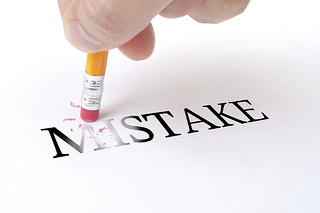 Nathan Yerian
Nathan Yerian
 You've taken your product and services through market testing and received favorable feedback from trusted experts in your field. You know your products and services can make a significant, measurable impact in the marketplace, but does your brand development strategy show that you are different and offer consistent positioning to achieve this?
You've taken your product and services through market testing and received favorable feedback from trusted experts in your field. You know your products and services can make a significant, measurable impact in the marketplace, but does your brand development strategy show that you are different and offer consistent positioning to achieve this?
Making these common branding mistakes could limit the potential growth of your business and jeopardize your bottom line. You can set your business apart by avoiding these six common branding mistakes with consistent marketing communications and a solid brand identity.
1. Does your logo effectively differentiate your brand and resonate with your audience?
Let's start by taking a look at your logo design. A weak logo or company name will be unrecognizable in today's flooded marketplace. If you want your brand voice to be heard loud and clear, your brand identity needs to be a true representation how how you are different and hopefully better.
-
What does your name imply?
If you sell sports cars, does your company name imply speed and precision? -
Does your brand mark leave an impression?
Does the shape, color and dimensionality of your brand mark possess enough depth to be remembered in the absence of your actual company name? -
Does your tag line create a memorable experience?
Will your tag line create enough of an impact to get customers to take notice and consider its meaning? -
Am I speaking to my audience?
Finally, ask yourself if your identity speaks directly to your target market. While it might be appealing to the masses, remember that your identity must be crafted with the customer in mind.
2. Do you have consistent branding across the web and offline touch points?
Whether you are a startup or a established firm ready to enjoy growth, your brand touchpoints will need to promote your brand position. You should have general brand guidelines that dictate how your identity elements should be used in different situations.
Online, you will need exceptional and consistent touch points across your website, social media platforms, emails, videos, press releases, etc. will help create a lasting impression that will support your online positioning efforts.
Your brand standards should also dictate the use of your brand offline. Remember that any inconsistency is diluting the position your brand has taken in the market. Don't be afraid to be a stickler. Look at these core areas for consistency:
-
Colors - Color matters. If your colors are off, it will be harder to be memorable. Additionally, you need to make sure that your are using complementary colors.
-
Fonts - The more consistently you use your font(s), the more memorable they will become. Think of some of your favorite brands. You can visualize the font they use. You are striving for this result. If you use fonts sporadically, this will never happen.
-
Voice - How you talk to you audience makes a difference in how they perceive what you are saying. In order to deliver a consistent message, make sure that you are using consistent tone, point of view and word choice.
3. Do you have multiple formats of business cards across your company?
This is a bit of an extension of 2, but simply put, there should be one business card used throughout the entire company. Your card is an extension of your brand. What is a potential client to think if they come to a meeting and get two different cards? If you recently redesigned your cards, be sure the entire company is supplied and asked to discard the old cards.
4. Does your PowerPoint Deck Effectively Portray Your Brand?
Use of a simple, consistently branded PowerPoint deck for presentations across the company will help avoid getting caught up in bells and whistles that can detract from the information you're trying to convey. It should also keep presentations within brand standard and save presenters from reinventing the wheel for each presentation.
5. Keep your tag line consistent.
As a general rule, have one tag line throughout your marketing. Many small businesses confuse their tag line with their advertising, email, or other marketing copy. You do not want to create a new tag line for each campaign. Instead, your tag line should be a statement about the essence of your position. Campaign copy should deliver value to the position of the tag line.
If you can't tell by now, the emphasis is on consistency. You have to be consistent to creating a lasting impression that will make you stand out in the marketplace. Let your branding and marketing efforts feature a consistent, dynamic branding identity that speaks for itself!
Image Credit: TerranceDC

